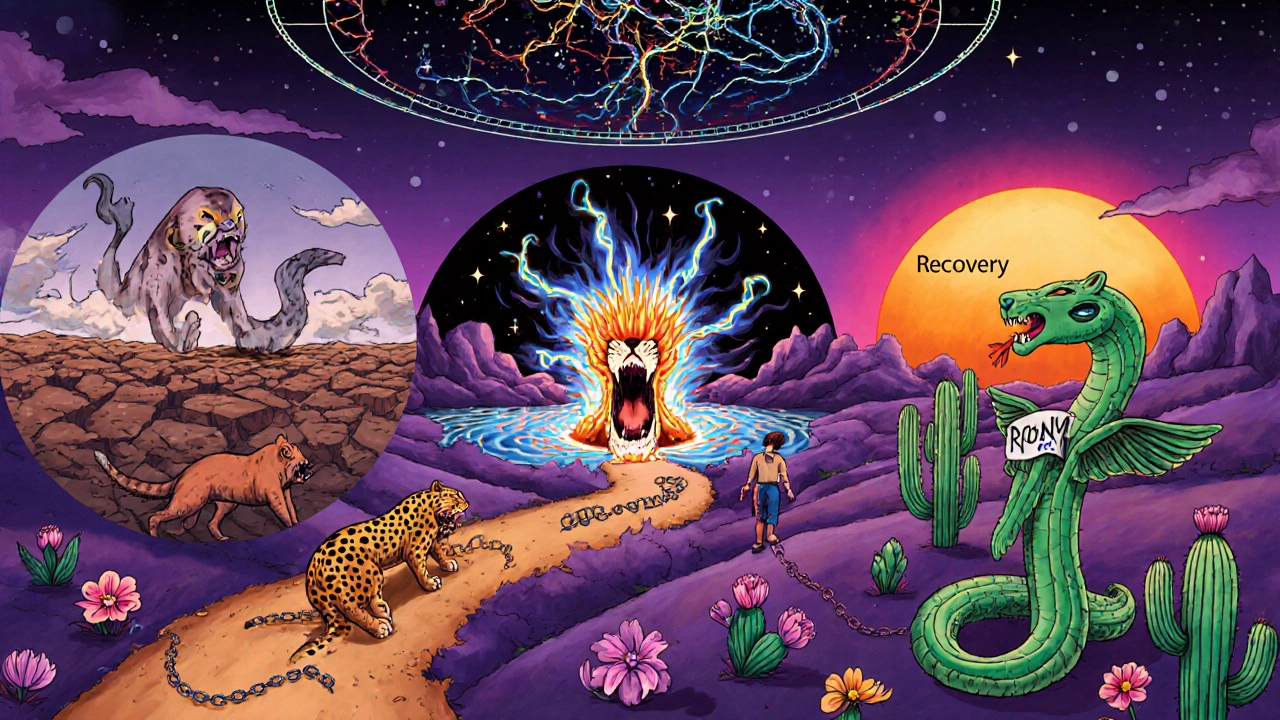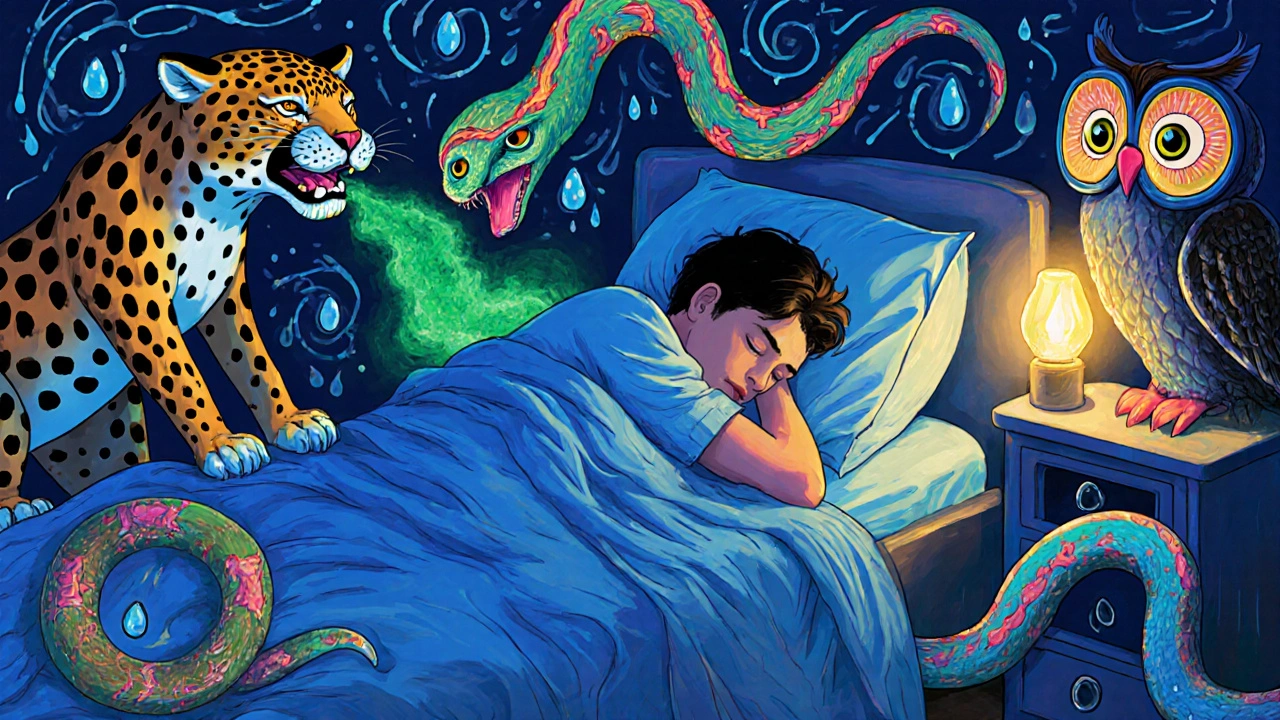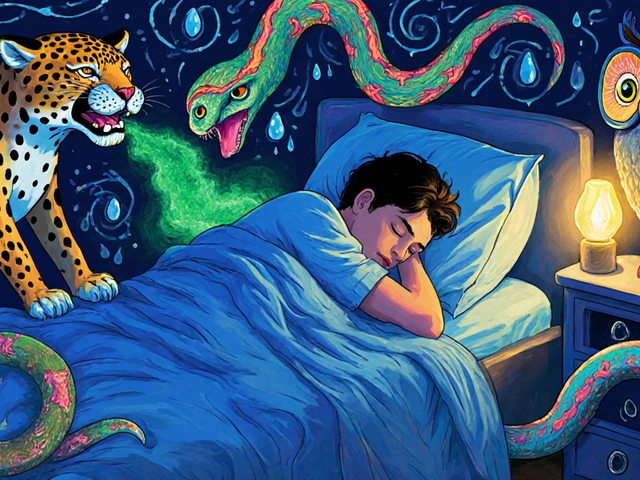Opioid Withdrawal Timeline Calculator
Select Opioid Type
Withdrawal Timeline Prediction
Onset Time
Peak Symptoms
Duration
Emotional Symptoms
Medical Recommendation
Medication-assisted treatment (MAT) with buprenorphine or methadone significantly reduces withdrawal severity and improves safety outcomes. Contact a healthcare provider immediately for proper medical guidance.
When someone stops using opioids after relying on them for weeks or months, their body doesn’t just adjust quietly. It reacts-often violently. Opioid withdrawal isn’t a choice. It’s a physical reality for anyone who has developed dependence, whether from prescription painkillers like oxycodone or heroin. The symptoms are brutal: sweating, shaking, nausea, cramps, anxiety, insomnia. And they come on fast. But knowing when they’ll hit and how to handle them can make all the difference between quitting cold turkey and getting through it safely.
When Do Opioid Withdrawal Symptoms Start?
The clock starts ticking the moment you take your last dose. But the timing depends entirely on what kind of opioid you were using. Short-acting opioids like heroin, hydrocodone, or immediate-release oxycodone begin causing withdrawal symptoms within 8 to 12 hours. You might notice a runny nose, yawning, or restlessness. These aren’t just "feeling off"-they’re your nervous system screaming for the drug it’s been conditioned to expect. Long-acting opioids like methadone or extended-release oxycodone play a different game. Withdrawal doesn’t show up until 24 to 36 hours after the last dose. That delay can trick people into thinking they’re fine. But when it hits, it hits harder and lasts longer. Symptoms can stretch out for two weeks or more. This isn’t guesswork. It’s based on how long each drug stays active in your body. Short-acting opioids clear out quickly, so your body crashes sooner. Long-acting ones linger, so your body has more time to adjust-until it doesn’t.What Does Opioid Withdrawal Feel Like?
Withdrawal symptoms follow a clear pattern, even if the experience feels chaotic. They usually come in three waves. Early stage (6-24 hours): This is when you start feeling like you’ve got the flu. Muscle aches, watery eyes, a runny nose, yawning, and trouble sleeping. Anxiety creeps in. You feel restless, on edge. It’s uncomfortable, but many mistake it for just being tired or stressed. Peak stage (48-72 hours): This is the worst. Your body goes into overdrive. You sweat profusely, even if the room is cold. Your stomach cramps. You throw up. You have diarrhea. Your pupils dilate. You can’t tolerate bright lights. Your bones ache. You feel like you’re being pulled apart from the inside. Emotionally, you’re raw-depressed, irritable, terrified. This is when most people relapse, not because they want the high, but because they can’t stand the pain. Late stage (7+ days): The physical symptoms begin to fade. The vomiting stops. The cramps ease. But the mental toll lingers. Depression, anxiety, insomnia, and cravings can stick around for weeks. This is the silent danger zone. People think they’re "over it," but their brain is still rewiring. Without support, this is where relapse happens. The Clinical Opioid Withdrawal Scale (COWS) is used by doctors to measure severity. A score of 5-12 means mild withdrawal. 13-24 is moderate. Above 37? That’s severe-and needs medical help. Most people don’t realize how high their score is until they’re assessed.How to Manage Opioid Withdrawal Symptoms
Trying to power through withdrawal alone is dangerous. It’s not a test of willpower. It’s a medical event. Medication-assisted treatment (MAT) is the gold standard. Three FDA-approved medications are proven to help:- Buprenorphine (Suboxone, Subutex): Reduces withdrawal symptoms by 60-70%. It’s a partial opioid agonist, meaning it eases cravings and discomfort without causing the same high. It’s taken as a tablet or film under the tongue. Since 2021, any licensed doctor can prescribe it-no special waiver needed.
- Methadone: A full opioid agonist used in clinics. It’s taken daily and slowly tapered. You don’t need to go through withdrawal to start methadone. That’s a myth. Starting methadone while still using opioids is safe and often recommended.
- Naltrexone: Blocks opioids from working. Used after detox, not during. It prevents relapse by making opioids ineffective if you use them again.
These aren’t "replacing one drug with another." They’re tools to stabilize your brain while it heals. The World Health Organization and SAMHSA agree: MAT saves lives. Without it, only 20-25% of people stay off opioids long-term. With it, that jumps to 40-60%.

What You Can Do at Home (With Medical Support)
Even with medication, you’ll still feel symptoms. Here’s how to manage them safely:- Hydration: Vomiting and diarrhea drain fluids fast. Drink at least 2-3 liters of water or oral rehydration solution daily. Electrolyte drinks like Pedialyte help. Avoid caffeine and sugary sodas-they make dehydration worse.
- Nutrition: Eat small, bland meals. Bananas, rice, toast, broth. Your gut is sensitive. Avoid spicy, fatty, or heavy foods.
- Rest: Sleep is hard, but your body needs it. Use dim lighting, white noise, and a cool room. Melatonin (3-5 mg) can help with insomnia, but talk to your doctor first.
- Heat and movement: Warm baths, heating pads on sore muscles, and light walking can ease body aches. Stretching helps too.
- Acupuncture: A 2019 meta-analysis found it reduced withdrawal symptoms by 25-30% in two-thirds of participants. It’s not magic, but it helps.
Don’t try to tough it out with over-the-counter meds alone. Imodium for diarrhea? Fine, but only short-term. Painkillers like ibuprofen can help aches, but they won’t touch the core of withdrawal. And never mix alcohol or benzodiazepines with opioids during withdrawal-that’s a recipe for overdose or respiratory failure.
Why Medical Supervision Matters
Detoxing at home sounds brave. But it’s risky. About 12-15% of people who quit opioids without medical help develop dangerous electrolyte imbalances from vomiting and diarrhea. That can lead to heart rhythm problems or seizures. The biggest danger isn’t the withdrawal itself-it’s what comes after. Once you’re clean, your tolerance drops fast. If you relapse and take the same dose you used before, you’re likely to overdose. Studies show overdose risk triples or even quadruples in the first four weeks after detox. That’s why the American Society of Addiction Medicine recommends different levels of care:- Ambulatory (outpatient): For mild cases. You visit a clinic daily.
- Intermediate: 20 hours per week of monitored care.
- Medically managed (inpatient): 24/7 care. Best for severe withdrawal, long-term users, or those with other health problems.
Facilities that follow strict protocols-checking COWS scores every 2-4 hours, ensuring hydration, and using medication appropriately-see 85-90% of patients complete detox. Without those steps, completion rates drop to under 50%.

What Happens After Withdrawal?
Withdrawal is just the first step. Recovery is the long game. Many people think once the physical symptoms are gone, they’re done. They’re wrong. The brain’s reward system is rewired. Cravings can pop up months later-triggered by stress, places, people, even smells. Ongoing treatment is non-negotiable. That means therapy-cognitive behavioral therapy, contingency management, peer support groups. It means continuing medication if needed. Studies show people who stay on buprenorphine or methadone for 6-12 months are far more likely to stay off opioids than those who quit after detox. New research is pushing boundaries. A 2023 study in the New England Journal of Medicine found a new extended-release buprenorphine formulation cut withdrawal symptoms by 45% in the first 72 hours. Genetic testing is also emerging-some people’s bodies process buprenorphine differently based on their CYP2B6 gene. In the future, treatment could be personalized from the start.Where to Get Help
You don’t have to figure this out alone. The opioid treatment landscape has changed dramatically. In 2021, the Mainstreaming Addiction Treatment (MAT) Act removed the X-waiver requirement, meaning nearly every doctor in the U.S. can now prescribe buprenorphine. That’s over a million providers, not just specialized clinics. Community health centers, urgent care clinics, and even some primary care offices now offer medication-assisted treatment. The Biden administration has invested $30 million to expand these services, aiming to help 500,000 more people by 2025. If you or someone you know is struggling, call the SAMHSA National Helpline at 1-800-662-HELP (4357). It’s free, confidential, and available 24/7. You don’t need insurance. You don’t need to be "ready." You just need to ask.Final Thought: Withdrawal Is Not the Enemy
Opioid withdrawal is painful. It’s scary. It feels like your body is betraying you. But it’s not a failure. It’s a sign your body is healing. The goal isn’t to suffer through it. The goal is to get through it safely-with the right tools, the right support, and the right care. You don’t have to do it alone. And you don’t have to be perfect. You just have to start.How long does opioid withdrawal last?
For short-acting opioids like heroin or hydrocodone, physical symptoms usually peak at 48-72 hours and fade within 7-10 days. For long-acting opioids like methadone, symptoms may take 14 days or more to fully resolve. Emotional symptoms like anxiety and cravings can linger for weeks or months without ongoing support.
Is opioid withdrawal dangerous?
Withdrawal itself is rarely life-threatening for healthy adults, but complications like severe dehydration, electrolyte imbalances, or cardiac stress can occur. The greatest danger is relapse after detox, when tolerance drops and overdose risk increases 3-5 times. Medical supervision greatly reduces these risks.
Can I detox from opioids at home?
It’s possible, but not recommended without medical guidance. Home detox carries higher risks of dehydration, relapse, and overdose. Medication-assisted treatment with buprenorphine or methadone significantly improves safety and success rates. Always consult a healthcare provider before stopping opioids.
What’s the best medication for opioid withdrawal?
Buprenorphine (Suboxone) is the most commonly used and effective medication for managing withdrawal symptoms. It reduces symptoms by 60-70%, has a lower risk of misuse than methadone, and can be prescribed by most doctors. Methadone is also effective but requires daily clinic visits. Naltrexone is used after detox to prevent relapse.
Do I need to go through withdrawal before starting buprenorphine?
No. This is a common myth. You don’t need to be fully detoxed to start buprenorphine. In fact, starting it too early can trigger sudden withdrawal. Doctors use the Clinical Opioid Withdrawal Scale (COWS) to time the first dose correctly-usually when mild symptoms begin. Starting treatment early improves outcomes and reduces suffering.
How can I prevent relapse after withdrawal?
Relapse prevention requires ongoing support. Continue medication-assisted treatment for at least 6-12 months. Attend counseling or therapy. Join peer support groups like Narcotics Anonymous. Avoid triggers-people, places, or situations linked to past use. Recovery is a process, not a single event.
Is acupuncture helpful for opioid withdrawal?
Yes. A 2019 meta-analysis in the Journal of Substance Abuse Treatment found acupuncture reduced withdrawal symptom severity by 25-30% in 67% of participants. It’s not a cure, but it’s a safe, non-drug option that can ease anxiety, nausea, and muscle aches when used alongside medical treatment.


This is the clearest guide I’ve ever read on withdrawal. Seriously, if you’re thinking of quitting, read this twice and then call a doctor. You don’t have to suffer alone.
They say MAT saves lives but who’s really controlling the prescriptions? Big Pharma’s been pushing these drugs for decades and now they’re the ones selling the cure. Coincidence? I think not.
withdrawal is just the soul screaming after the body gets its fix 🥲
we’re all just addicts to something-pain, love, control
the body breaks so the mind can wake up
so like… the whole ‘tough it out’ thing is just a myth made by people who’ve never felt their bones ache for 3 days straight? 😭
also why is everyone acting like buprenorphine is some miracle drug? it’s still a narcotic lol
they just call it ‘treatment’ now so it sounds less sketchy
Man, this post hits different. I’ve seen friends go through this and honestly? The worst part isn’t the vomiting or the cramps-it’s the silence afterward. People disappear. Friends stop calling. Family acts like it never happened.
But here’s the thing-recovery doesn’t start when the withdrawal ends. It starts when someone says ‘I’m here’ and actually means it.
And yeah, acupuncture? I’ve seen it work. Not magic, but real. Like someone gently holding your hand while your body screams.
wait so you can start buprenorphine BEFORE you’re fully detoxed?? 😳
that changes EVERYTHING. why didn’t anyone tell me this before??
also 🫂 to anyone reading this-you’re not weak for needing help
In many cultures, the notion of surrendering to medical intervention is seen as a loss of dignity. Yet here we are-modern medicine offering tools that honor the body’s need to heal, not punish it.
Perhaps the greatest revolution isn’t in the drugs, but in the shift from moral judgment to compassionate care. This post embodies that shift. Thank you.
Everyone talks about buprenorphine like it’s the answer but no one mentions how hard it is to get a doctor who actually knows what they’re doing. I waited six months just to get an appointment. Meanwhile my cousin OD’d in his apartment. Guess who got help? The one with insurance.
They sell you hope but the system still leaves you in the dark.
Let me be very clear-this whole ‘medication-assisted treatment’ is just corporate welfare for pharmaceutical giants who turned addiction into a lifetime subscription model. You think they care about your recovery? They care about your refill rate.
And don’t get me started on acupuncture-some hippie nonsense with needles that costs $150 a session while real painkillers are banned. The system is rigged. They want you dependent on their version of ‘help’ so you never question why you got hooked in the first place.
Real recovery means going cold turkey, facing the pain, and breaking the cycle with sheer will. Not trading one pill for another. That’s not healing-that’s corporate conditioning.